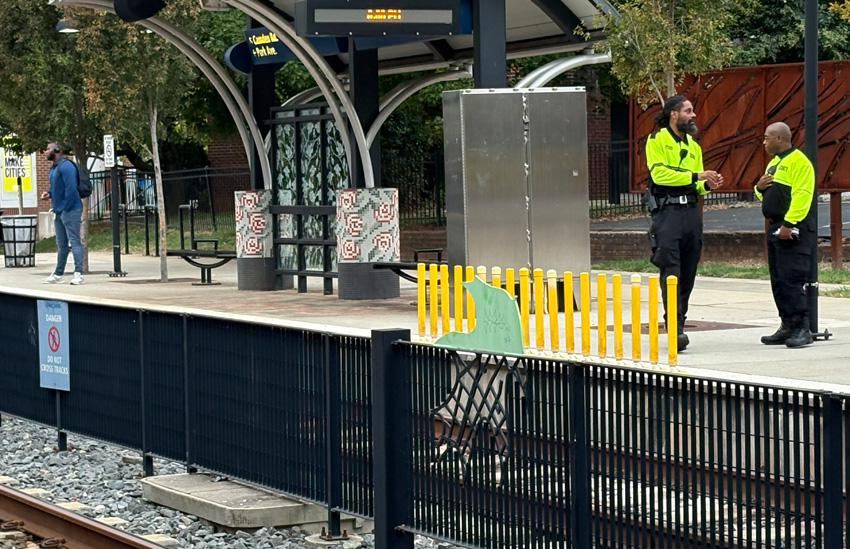By Cameron Williams
The Charlotte Post
The city of Charlotte is taking measures to ensure the safety of commuters on public transit.
Last week’s announcement of steps to address safety upgrades on Charlotte Area Transit System routes and vehicles are in response to the Aug. 22 stabbing death of Iryna Zarutska, 23 on the Lynx Blue Line. Decarlos Brown Jr., 34, was charged with murder as well as a federal charge of committing an act causing death on a mass transportation system. He has pleaded not guilty.
“Many of you know that I have been in this situation before and having to have this loss of Iryna Zarutska, it’s been a terrible time for all of us,” Mayor Vi Lyles said at a press conference. “We know the violence was on our light rail, but we also know that our city is mourning this loss and will likely never forget it. No one in Charlotte should feel unsafe about getting to work, school or home to their family.”
Lyles said the city has been working with the White House, other federal officers and assistants to ensure that CATS adds patrol units like bike teams and all-terrain vehicles.
“These are not things that were promised,” she said. “These are the things that we are doing. These steps are in motion. Our city departments, CATS leadership and federal and state partners are sitting at the same table, sharing information and coordinating and collaborating each step of the way safety is taking care if all of us work together. And I want to be clear that I often hear from our neighbors, our residents, the people that live in this great city, who just want to feel safe.”
City manager Marcus Jones outlined new measures taken to ensure transit safety as well as police pay.
“I wanted to start off by just saying how important public safety is to our city,” he said. “It’s what we do. The City Council has spent the better part of the last year and a half having discussions around public safety. What’s very clear is that while there are many things that we can do, there’s more that has to be done.
“We have multiple city departments and multiple agencies that play a role in safety, but in terms of the city of Charlotte, about 40% of our general fund budget is solely for police. Forty percent of our general fund budget supports police. When you add fire [fighters] to it, it’s about 60% of our general fund budget. Over the past several years, we have made tremendous investments in public safety.
Jones said recent changes in promotions and compensation have helped with first responder retention. Some job vacancies have been shifted to civilian positions, so patrol officers don’t have to fill roles like the 911 center.
“What I do is I have opportunities with our Public Safety Pay Plan Committee… and we talk about what’s important for attracting great people in public safety as well as retaining them,” he said. “So, since 2019 we have increased the starting salary for police by 34% and the top out salary by 41%.
CATS interim CEO Brent Cagle said new equipment being deployed to help ensure the safety of rail and bus commuters like new bikes and all-terrain vehicles to move security officers.
“It really is a visual way to show our commitment to safety and security throughout transit. The partnership with [Professional Police Services] is growing and evolving as we work together to ensure the safety of our operators, our customers, and as we work to reduce or eliminate variation throughout the system. All of these are top priorities and CATS with PPS, and in partnership with [Charlotte Mecklenburg Police], we are ready to implement and execute on these plans.”
Said Jones: “We work with community leaders; we work with the business community with a focus on a comprehensive plan as relates to public safety. More will come in the next week or two, but I want you to know that we focused on various areas in our city, starting with the Uptown, but not limited to Uptown. We have additional resources in our Central Division. We have targeted patrols, and targeted response for intervention and outreach. We’re working more to make sure that we can keep our community safe.”
Cagle added that he did not think it was feasible to have armed security at every CATS station.
“We also don’t believe it creates a force that can stay mobile to respond throughout the system,” he said, “if there are significant numbers of security on every vehicle. If those trains need to be stopped for some reason, that means those security officers are stationary with that train. And so again, it’s not about there being personnel on every vehicle every day, all day long. It’s are personnel visibly present throughout the entire system.”
There will also be increased emphasis on preventing fare evasion as a measure to improve commuter safety.
“We have a lot to do,” Lyles said, “and I hope that you understand that that’s why we’re standing here today, is to answer as many questions as possible, but also to think about what would be the best thing to help our city be who we can be.”

